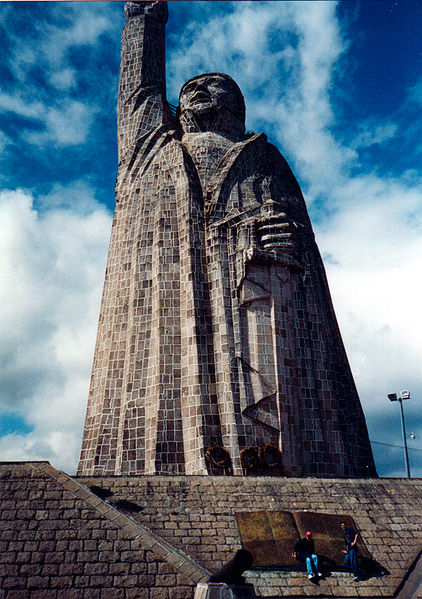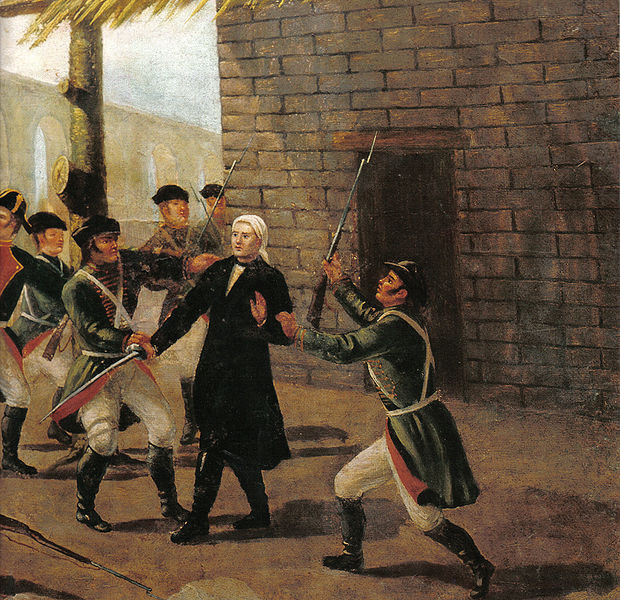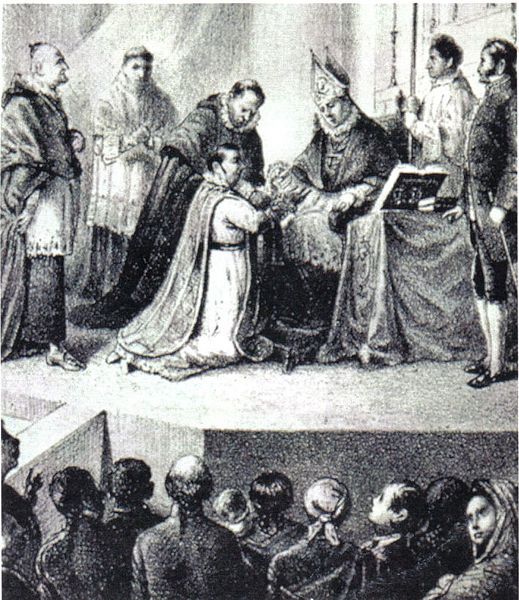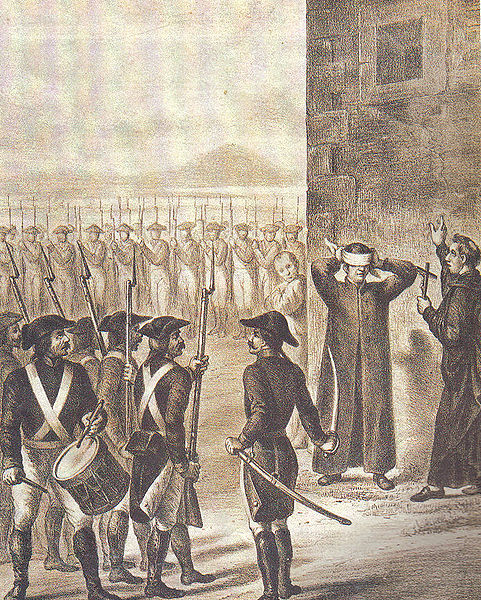<Back to Index>
- Philologist and Physician Geronimo Mercuriali, 1530
- Poet Jalāl ad-Dīn Muḥammad Rūmī, 1207
- Mexican Revolutionary José María Teclo Morelos y Pavón, 1765
PAGE SPONSOR
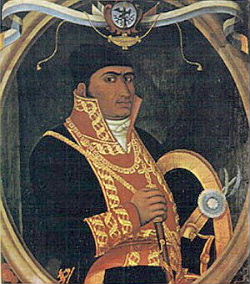
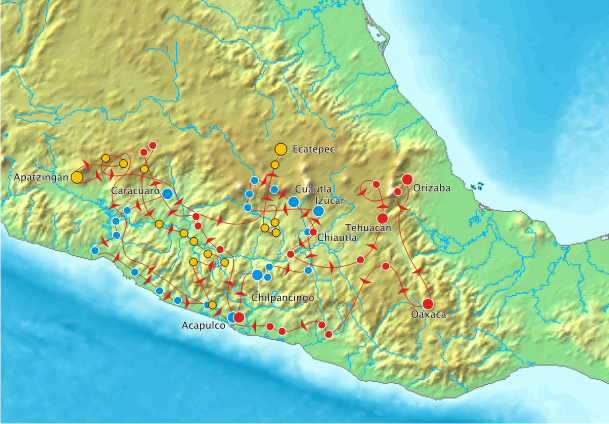
José María Teclo Morelos y Pavón (September 30, 1765, Valladolid, now Morelia, Michoacán – December 22, 1815, San Cristóbal Ecatepec, State of México) was a Mexican Roman Catholic priest and revolutionary rebel leader who led the Mexican War of Independence movement, assuming its leadership after the execution of Miguel Hidalgo y Costilla in 1811. He was later captured by the Spanish colonial authorities and executed for treason in 1815.
Morelos was born into a poor mestizo family in the city of Valladolid, since renamed "Morelia" in his honor, in a house that is today a museum dedicated to his legacy. His father was Manuel Morelos, a carpenter originally from Zindurio, a predominantly indigenous village a few kilometers west of Valladolid. His mother was Juana María Guadalupe Pérez Pavón, originally from San Juan Bautista de Apaseo, also near Valladolid. Valladolid was the seat of a bishop and of the government of the colonial Intendency of Michoacán. It was known as the "Garden of the Viceroyalty of New Spain" because of its prosperity.
On September 15, 1810, Hidalgo y Costilla, the former leader of the College of San Nicolás, then the parish priest of Dolores, Guanajuato (since renamed Dolores Hidalgo in his honor), called for armed revolt after the Spanish colonial authorities discovered the Conspiracy of Querétaro. The other conspirators included Josefa Ortiz de Domínguez, Ignacio Allende and Juan Aldama. Hidalgo y Costilla and his followers rose in open revolt the following day.
After taking all the important cities of the Bajío region and being proclaimed captain general of Mexico in Celaya on September 21, Hidalgo y Costilla advanced as far as Guanajuato. There on September 28, the rebels captured the Alhóndiga de Granaditas in battle, killing more than 700 Spaniards who had taken shelter there. Among the dead was the intendent of Guanajuato, Juan Antonio Riaño, an old friend of Hidalgo y Costilla.
The Mexican revolutionary army was excommunicated by the bishop of Michoacán, Manuel Abad y Queipo, another former friend of Hidalgo y Costilla. Hidalgo y Costilla and his army marched on to Valladolid, where the locals feared that the slaughter of Guanajuato would be repeated, prompting many people to abandon the region, particularly the rich and middle class society. However, Valladolid was taken peacefully on October 17, 1810.
In Tacámbaro Hidalgo y Costilla was proclaimed general, and Allende captain general. Hidalgo y Costilla ordered a rest for his troops in Indaparapeo,
where a few minutes before their departure, Morelos, who had read about
his excommunication and his triumphs, found him. Still serving as the
parish priest of Cuarácuaro, Hidalgo y Costilla asked Morelos to
join the army. Morelos was promoted as colonel of the revolution army,
ordering him to raise troops in the south and capture Acapulco, to disrupt the commerce and trade with the Philippine Islands. Morelos
soon showed himself to be a talented strategist, and became one of the
greatest revolutionary military commanders of the war. In his first
nine months, he won 22 victories, annihilating the armies of three
Spanish royalist leaders and dominating almost all of what is now the
state of Guerrero.
In December, he captured Acapulco for the first time, except for the
fortress of San Diego. Spanish reinforcements forced him to raise the
siege in January. By quick marches, he was able to capture most of the
Spanish possessions on the Pacific coast of what are now
Michoacán and Guerrero. On May 24, 1811 he occupied Chilpancingo and on May 26 he took Tixtla. In his second campaign, Morelos divided his army into three groups. The most important engagement of this campaign was at Cuautla, where his forces were besieged by the Spanish army under general Félix María Calleja del Rey. On May 2, 1812, after 58 days, Morelos broke through the siege, and started his third campaign. Major victories on this third campaign were at Citlala on June 8, 1812, Tehuacán on August 10, 1812, Orizaba, Oaxaca and
Acapulco. Morelos arrived at Orizaba with 10,000 soldiers on October
28, 1812. The city was defended by 600 Spanish soldiers. Negotiation
led to a surrender without bloodshed. He entered Oaxaca in triumph on
November 25, 1812. Acapulco fell on April 12, 1813, forcing the Spanish
army to take refuge in Fort Baltimore. In 1813, Morelos called the National Constituent Congress of Chilpancingo,
composed of representatives of the provinces under his control, to
consider a political and social program which he outlined in a document
entitled "Sentimientos de la Nación" (Sentiments of the Nation). On
September 13, 1813, the Congress, with Morelos present, endorsed the
"Sentiments of the Nation". This document declared Mexican independence
from Spain, established the Roman Catholic religion and created the
legislative, executive and judicial branches of government. It declared
respect for property and confiscated the productions of the Spanish colonial government. It abolished slavery and racial social
distinctions in favor of the title "American" for all native-born
individuals. Torture, monopolies and the system of tributes were also
abolished, Morelos was offered the title "Generalissimo" with the style
of address "Your Highness", but he refused these and asked to be called
"Siervo de la Nación" (Servant of the Nation). After several military defeats, the Congress organized a meeting in Apatzingán, and on October 22 promulgated the "Decreto Constitucional para la Libertad de la América Mexicana" (Constitutional Decree for the Liberty of Mexican America).
This established a weak executive and a powerful legislature, the
opposite of what Morelos had called for. He nevertheless conceded that
it was the best he could hope for under the circumstances.
Shortly
thereafter, Morelos began his fourth military campaign, a series of
disasters beginning at Valladolid in late 1813. While escorting the new
insurgent Congress in November 1815, he was defeated in Tezmalaca.
He was taken prisoner and brought to Mexico City in chains. He was
tried and executed for treason. José María Morelos y
Pavón was executed by firing squad on December 22, 1815 in San
Cristóbal Ecatepec, near Mexico City. He was later judged to be
reconciled to the church, lifting his excommunication, as he was seen
praying on his way to his execution. After his
death, his lieutenant, Vicente Guerrero, continued the war of independence.
Morelos is a national hero of Mexico. In his honor, the state of Morelos and city of Morelia is named after him. Morelos' legacy has been portrayed on the 50 peso note since 1997; 1 peso coins during the 1940s, 1970s and 1980s.
